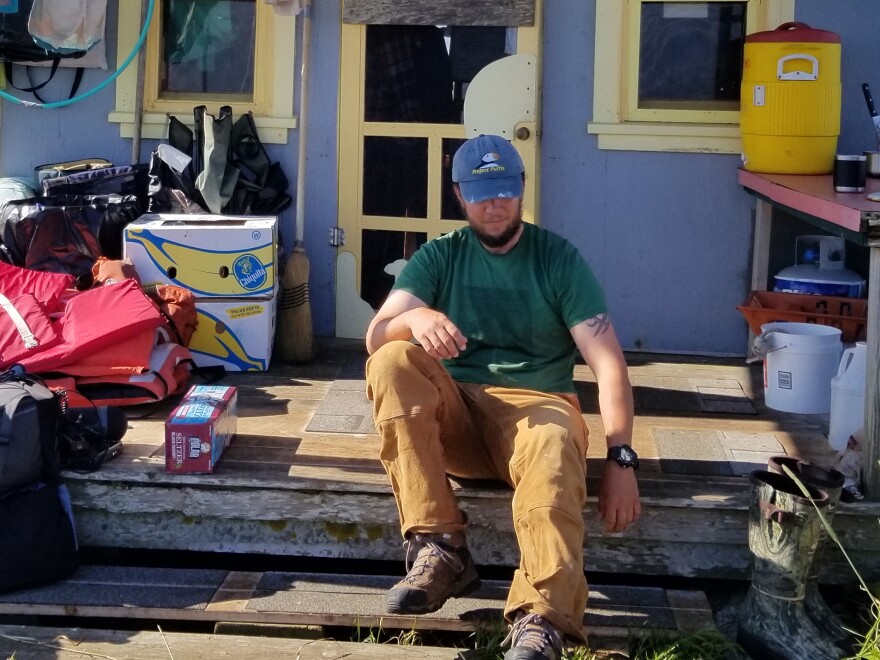Every summer, a handful of interns and research assistants are selected from hundreds of applicants to camp in primitive conditions on a tiny, treeless island several miles off Maine's coast. Their job description calls for "a sense of humor and love ... of adventure, the outdoors and birds."
The coveted jobs are with the National Audubon Society's Project Puffin, an unusual seabird restoration project that got its start on Eastern Egg Rock in the 1970s.
It takes about 30 minutes by boat to reach the 7-acre island, which is bordered by slippery, seaweed-covered boulders. Hundreds of screeching terns and gulls circle overhead. Sarah Guitart says she sometimes wishes the birds weren't quite so loud.
"You gotta remember that you're in a seabird colony and it's pretty wonderful."
Guitart is the crew lead for the four interns and research assistants living and working on the island from May to August. She wears earplugs to get to sleep in her tent at night.

Atlantic puffins are actually quieter than a lot of the other birds on the island. They're cute and colorful with their tuxedo-looking suits of black and white feathers and their bright orange beaks and feet. By the late 1800s, they'd mostly disappeared from their historical nesting grounds in the Gulf of Maine, killed off by hunters for food and feathers.
More than a century later, the puffins are back. Stephen Kress, vice president of bird conservation for the National Audubon Society, is the founder of Project Puffin. In 1973, with permission from the U.S. government, he started transporting puffin chicks from a healthy colony in Newfoundland to Eastern Egg Rock. The effort paid off and eventually expanded. There are now 1,300 pairs on five Maine islands.
Examining a puffin chick that has been pulled from a burrow to be measured, Kress seems satisfied. "So I'd say it's very much on target," Kress says. "There seem to be enough small fish." Adult puffins carry fish to their young until the juvenile birds are old enough to fish for themselves.
While the puffin population on Eastern Egg Rock is stable, Kress says it remains small and vulnerable to disease and predators like gulls, which the interns occasionally have to shoot. But there's not much they can do to protect the birds from rapid warming in the Gulf of Maine. Twice a day, surface temperatures are taken to look for changes that might affect the small fish that the puffins and other seabirds need to eat.
Nadia Swanson, a recent college graduate with a degree in wildlife ecology, scoops up a bucket of water, drops a thermometer in and waits.
"Eww. It's like 62 degrees. This morning it was 60 degrees, so it got a little warmer, but it's not like abnormal. It's usually between 60 and 64 degrees."
That may seem warm, unless you need a shower and the Gulf of Maine is your only option. Out here there's no running water. Hats and long sleeves are essential because bird droppings are a constant. The days are long, often starting before 6 a.m., and the pay is low. But interns are here for a different reason.
"I'm interested in marine ecology, and seabirds are fantastic indicators of the marine ecosystem," says Guitart.
The job requires spending several hours at a time in a bird blind, documenting birds' nesting and feeding habits and carefully recording the data. It also involves "grubbing" for different species of chicks — reaching into deep, narrow burrows to pull them out, measure and band them.

"It was sort of a dream come true to work out here. It's something special," says Michael Rickershauser, a former auto mechanic from Long Island. "It's more than seeing a picture or reading a book."
Over Project Puffin's 46-year history, more than 500 interns have worked on several Maine islands protecting puffins and other seabirds. Kress says the main lesson he hopes they've learned is that people can push a species to the brink of extinction but they can also help bring it back.
Copyright 2024 Maine Public



